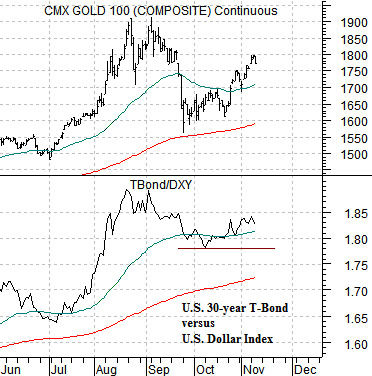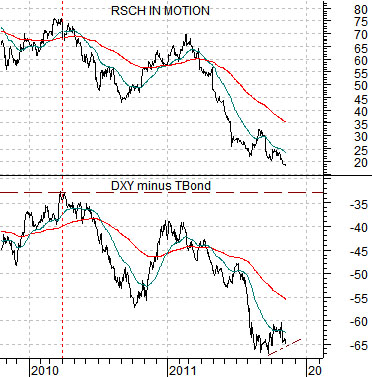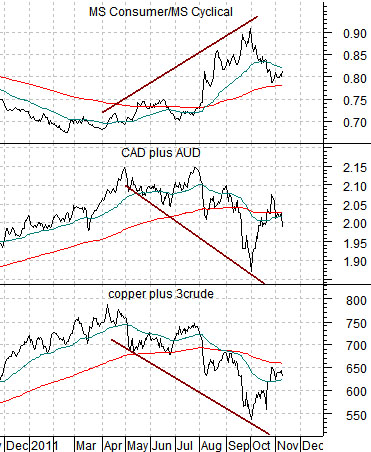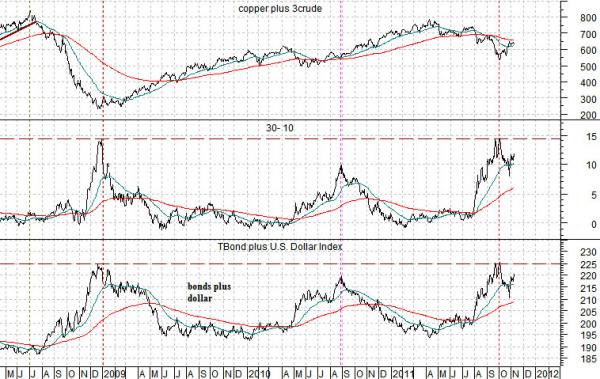Both the U.S. dollar and long-term Treasury markets were higher in price yesterday with cyclical asset prices under pressure. We haven’t run through the four possible combinations derived from the dollar and U.S. 30-year T-Bond futures for awhile so we thought that we would start off today by doing a quick refresher.
The bond market determines the cyclical trend. Rising yields are a positive while falling yields are a negative. The stock market can rise or fall on either outcome. Rising yields will go with strength in the economically sensitive sectors while falling yields go with relative strength in the defensive groups.
The dollar reflects the flow of money to or away from the U.S. A weak dollar tends to go with capital moving away from the U.S. towards the smaller markets while a stronger dollar represents money moving towards the U.S. Once again the stock market can rise or fall on either outcome although a stronger dollar will tend to go with relative strength in the U.S. large caps.
There are four basic combinations. The chart at top right compares gold futures with the ratio between the TBond futures and the U.S. Dollar Index. The TBond/DXY ratio rises when the bond market is stronger than the dollar. Rising bond prices go with economic weakness while a falling dollar helps support commodity prices. This particular combination tends to move quite closely with gold prices.
The inverse of a strong bond market and weak dollar is, of course, a weak bond market and stronger dollar. We have included a comparison below right between Research in Motion (RIMM) and the price spread or difference between the U.S. Dollar Index and TBonds.
The price spread declines when the dollar is weaker than the bond market and rises when the dollar is stronger than the bond market. This is both the inverse of the trend for gold and the key ‘driver’ for the tech sectors.
The point is that rising bond prices and a weak dollar favors gold while falling bond prices and a stronger dollar is more positive for tech. In recent months gold prices have risen while RIMM continues to make new lows.


Below is a comparison between, from bottom to top, the sum of the TBond futures and U.S. Dollar Index, the price difference between 30-year and 10-year Treasuries, and the sum of copper and crude oil.
When the sum of the TBond and DXY is rising the cyclical trend tends to be negative. Rising bond prices point to slower growth while a stronger dollar represents money moving away from foreign markets towards the U.S.
In recent years both the commodity markets and equity markets have trended very tightly with this combination. A weak dollar and weak bond prices has led to rising commodity and equity prices while a strong dollar and rising bond market has created downward pressure. Such was the case yesterday.
The twist is that it is not a given that the S&P 500 Index will collapse each and every time the bond market and dollar move higher. That has most certainly been the case over the past few years but we only have to go back to the mid-1990’s to see that this particular combination led to a major equity bull market.
The chart below compares the sum of copper and crude oil, the sum of the Canadian and Australian dollar futures, and the ratio between the Morgan Stanley Consumer Index and Cyclical Index.
The only thing that is assured when the dollar and bond market rise in tandem is relative strength in the consumer stocks versus the cyclicals. If the consumer stocks outperform by rising in price- as they did in the 1990’s- the stock market will rise. If they outperform by falling at a slower pace- as was the case in 2008- then the stock market will decline.





